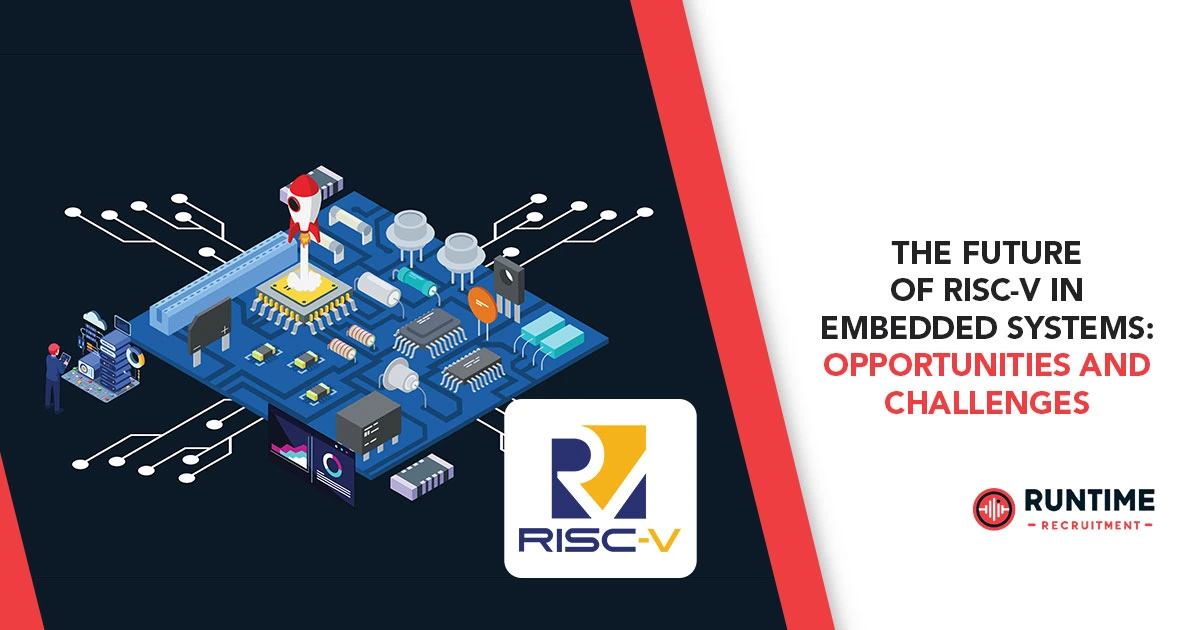The embedded systems industry is undergoing a significant transformation, driven by the increasing demand for customizable, power-efficient, and cost-effective processor architectures. Among the emerging trends, RISC-V has gained substantial traction as an open-source instruction set architecture (ISA) that promises flexibility, scalability, and freedom from licensing restrictions.
For embedded engineers, RISC-V presents both exciting opportunities and unique challenges. This article explores the future of RISC-V in embedded systems, examining its advantages, potential applications, and the hurdles that must be overcome for widespread adoption.
Understanding RISC-V and Its Relevance to Embedded Systems
What is RISC-V?
RISC-V (pronounced “risk-five”) is an open-standard ISA based on reduced instruction set computing (RISC) principles. Unlike proprietary architectures like ARM or x86, RISC-V is license-free, allowing anyone to implement, modify, and extend the ISA without royalty payments.
Why RISC-V for Embedded Systems?
Embedded systems require low power consumption, real-time performance, and customization—qualities that align well with RISC-V’s strengths:
- Customizability: Engineers can extend the ISA with domain-specific instructions.
- Modularity: Optional extensions (e.g., floating-point, DSP, vector operations) allow tailored implementations.
- Cost Efficiency: No licensing fees reduce development costs.
- Security: Openness enables transparent security audits and custom security features.
Given these benefits, RISC-V is increasingly being adopted in IoT devices, microcontrollers, automotive systems, and industrial automation.
Opportunities for RISC-V in Embedded Systems
Growth in IoT and Edge Computing
The Internet of Things (IoT) and edge computing demand energy-efficient, scalable processors. RISC-V’s modularity allows chipmakers to design ultra-low-power cores for sensors and edge AI accelerators. Companies like SiFive, Espressif (ESP32-C series), and Western Digital are already deploying RISC-V in IoT applications.
Custom Accelerators for AI/ML Workloads
Machine learning at the edge requires specialized hardware. RISC-V’s extensible ISA enables custom AI accelerators, avoiding the limitations of fixed architectures. Startups like Esperanto Technologies and GreenWaves Technologies are leveraging RISC-V for AI inference chips.
Real-Time and Safety-Critical Systems
Embedded systems in automotive, medical devices, and industrial control require deterministic performance and functional safety (ISO 26262, IEC 61508). RISC-V’s simplicity allows for certifiable real-time operation, making it a viable alternative to ARM Cortex-M and proprietary DSPs.
Open-Source Ecosystem and Collaboration
The RISC-V ecosystem is growing rapidly, with contributions from academia, startups, and semiconductor giants (NVIDIA, Qualcomm, Intel). Open-source RISC-V cores (e.g., PULP, SweRV, VexRiscv) and tools (GCC, LLVM, FreeRTOS) lower barriers to entry.
Geopolitical and Supply Chain Advantages
With increasing restrictions on semiconductor exports (e.g., US-China trade tensions), RISC-V provides a neutral, vendor-independent alternative to ARM and x86, reducing reliance on proprietary architectures.
Challenges Facing RISC-V Adoption
Despite its promise, RISC-V faces several hurdles before becoming mainstream in embedded systems.
Fragmentation and Standardization Issues
- RISC-V’s flexibility leads to fragmentation—different vendors implement custom extensions, risking software incompatibility.
- The RISC-V International consortium is working on standardization, but widespread compliance remains a challenge.
Maturity of the Software Ecosystem
- While GCC, LLVM, and Zephyr RTOS support RISC-V, proprietary tools (Keil, IAR) still dominate embedded development.
- Debugging and profiling tools (e.g., Trace32, SEGGER) need better RISC-V integration.
Performance and Optimization Gaps
- High-performance RISC-V cores (e.g., SiFive U7-series) are emerging, but ARM Cortex-A/M still leads in power efficiency and performance-per-watt.
- Lack of vendor-optimized libraries (e.g., ARM CMSIS-DSP) for RISC-V impacts DSP and ML workloads.
Security Concerns in Open-Source Hardware
- Open-source designs raise concerns about side-channel attacks (e.g., Spectre, Meltdown).
- RISC-V Privileged Architecture and Physical Memory Protection (PMP) are evolving but need hardening.
Industry Adoption and Market Resistance
- Many embedded engineers are comfortable with ARM and reluctant to switch.
- Legacy codebases and vendor lock-in (e.g., STM32Cube, NXP MCUXpresso) slow RISC-V adoption.
4. The Road Ahead: How RISC-V Can Succeed in Embedded Systems
Strengthening the Ecosystem
- Standardized extensions (e.g., Vector, Bitmanip) must be widely adopted.
- More commercial RTOS support (e.g., FreeRTOS, Zephyr, Micrium) is needed.
Improving Toolchain and Debugging Support
- Better IDE integrations (VS Code, Eclipse) and JTAG debugging tools.
- Vendor-backed optimized libraries for DSP, ML, and cryptography.
Bridging the Performance Gap
- Advanced out-of-order (OoO) RISC-V cores (e.g., Ventana Veyron) will compete with ARM Cortex-A.
- Silicon-proven designs from major foundries (TSMC, Samsung) will boost confidence.
Security and Certification
- Formal verification of RISC-V cores (e.g., CHERI extensions for memory safety).
- Safety-certified RISC-V MCUs for automotive (ISO 26262 ASIL-D) and industrial use.
Industry Collaboration and Education
- More university programs teaching RISC-V design.
- Cross-industry partnerships (e.g., RISC-V in AUTOSAR, ROS 2).
Conclusion: RISC-V’s Role in the Future of Embedded Systems
RISC-V is poised to disrupt the embedded industry, offering unparalleled flexibility, cost savings, and innovation potential. However, challenges in standardization, tooling, performance, and security must be addressed for widespread adoption.
For embedded engineers, now is the time to explore RISC-V, contribute to its ecosystem, and prepare for a future where open-source hardware plays a central role in embedded design.
The journey won’t be easy, but the rewards—freedom from licensing, custom accelerators, and a collaborative global ecosystem—make RISC-V a compelling choice for the next generation of embedded systems.









